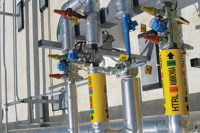
Today, those add-ons are becoming more and more important as supermarkets deal with issues related to energy efficiency. Nowhere is that more important than in Southern California, where a few years ago efficiencies were not just a matter of saving a few dollars — they were vital to staying in business.
For it was just a few years ago that California was facing a serious energy crunch. The state’s power providers just could not deliver enough electricity for their customers. Blackouts became commonplace. About the only way the state was initially able to deal with the crisis was to encourage conservation and set up a system of rolling brownouts, informing various groups of customers when they were going to be without power and for how long.
In recent months, the issue has calmed down somewhat as the utility companies have been able to buy power from adjoining states and its customers have demonstrated energy-saving effectiveness. But the recent blackout in parts of the Northeast and Midwest has again brought the issue to the forefront.

Making A Difference For Customers
One company in the midst of the supermarket and convenience store energy issues in California is Pacific Refrigeration Inc. of El Cajon. It is a company that has some 1,500 customers throughout San Diego County, including 300 convenience stores and a number of supermarkets ranging in size from 15,000 to 60,000 square feet.In the “bad old days” of just a few years ago, Pacific Refrigeration’s supermarket guru George Misleh found himself and his colleagues making mad dashes from supermarket to supermarket every time they got a warning about power cuts. They spent about two hours each time shutting down the store and then standing by at the store during the power outages, which often lasted more than 90 minutes at a time.
Today, all supermarket equipment Pacific installs is fully computerized with VFD and subcooling. “That’s standard for us and it creates a more efficient system,” said Misleh.
Pacific is manufacturer-specific, offering Cornelius ice machines, Remcor ice and fountain dispensers, Jet Spray beverage dispensers, Everpure water filtration systems, Master-Bilt walk-ins and reach-ins, True equipment, Hussmann supermarket equipment, Anthony Manufacturing glass display doors, Rheem and Trane air conditioning and heating systems, as well as products from Heatcraft, Climate Control, Krack, Copeland, and Tecumseh.
In some instances the product lines are the result of sales managers and others coming from specific manufacturers. Misleh himself was formerly a factory rep for Hussmann. At Pacific, he deals exclusively with supermarkets. “I eat, sleep, breathe, and do supermarkets,” he said.
If those brand names seem to run the gamut of HVACR, there is a reason for that. President Robert Lerwill wants Pacific to be able to offer a full-service contract covering every aspect of facility mechanicals, right down to bun warmers and coffee makers.
The company was founded by Lerwill in 1971, after he had spent a number of years with ACCO Refrigeration. About 95 percent of Pacific’s business is refrigeration-related, the balance HVAC.
The company has 38 employees, including 28 technicians in the field. As a non-union shop, Misleh said potential technicians are sought from other companies or from trade schools. There are hiring exams and a 90-day probation period.
Training is primarily done in-house and includes a large inventory of technical manuals. “My office is a library,” said Misleh.
Misleh also noted that employees have long tenures with the company, with many having put in 10 to 20 years and beyond.
Training Routes
The training also extends beyond the Pacific employees. One example is a three-hour seminar put on by Pacific as part of a regular series of events presented by the San Diego Regional Energy Office.Misleh conducted the Advanced Refrigeration Systems program for facility managers, engineers, consultants, and technicians. It covered the history, design, energy-saving opportunities, and upcoming trends in refrigeration systems for supermarkets, grocery stores, restaurants, and hospitality facilities.
The session gets highly detailed, covering such topics as heat reclaim, hot water reclaim, oil level control, condensers, defrost systems, pressure regulators, sub-cooling, refrigerants, VFD, energy management, and direct drive compressors.
The Supermarket Sector
A presentation before facility managers, engineers, and consultants, as well as technicians has a practicality behind it. Misleh noted that more and more supermarket and convenience stores are becoming part of large chains.That means decisions about mechanical needs for hundreds of stores might be made by a few people at the corporate level who may be far removed from the area where the store is to be constructed.
For that reason, companies like Pacific, as well as major manufacturers, want to reach those key decision makers to make sure they are aware of the latest technologies and products available.
For more information on Pacific Refrigeration, call 619-441-6960 or visit www.pacref.com.
Publication date: 09/01/2003





